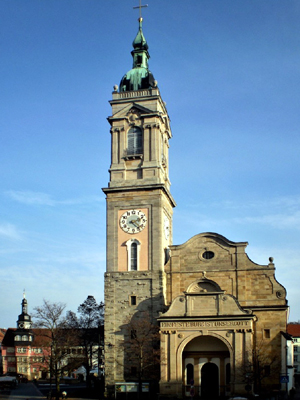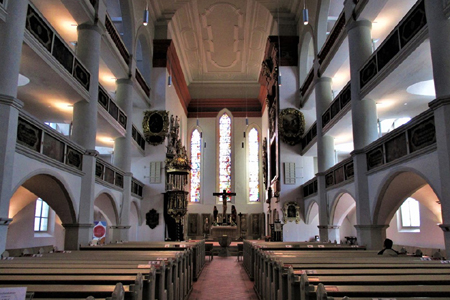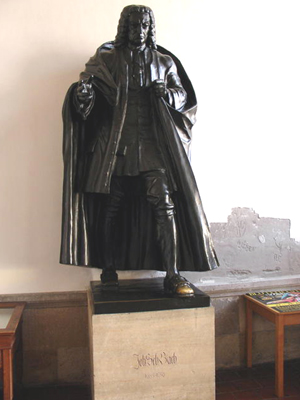| |
 |
 |
 |
| Comment on this report, or find other reports. |
 |
| Our Mystery Worshippers are volunteers who warm church pews for us around the world. If you'd like to become a Mystery Worshipper, start here. |
 |
| Find out how to reproduce this report in your church magazine or website. |
|
|
| 3173: St Georgenkirche, Eisenach, Germany |
 |
 |
 |
Mystery Worshipper: Portola.
The church: St Georgenkirche (St George’s Church), Eisenach, Germany.
Denomination: Evangelical Church in Middle Germany.
The building: St George's was built at the end of the 12th century.
The Peasant’s Revolt of 1525, a radical-militant version of the Reformation, inflicted heavy damage on the church. During various reconstructions three balconies were added.
The tower, added in 1902, is decorated with the first line of Luther’s most famous hymn “Ein feste Burg ist unser Gott” (“A mighty fortress is our God”).
In the entrance hall is a large statue of Johann Sebastian Bach, erected 1939. The left foot of Bach is brighter than the rest of the statue, indicating that visitors greet Bach by rubbing (or kissing?) the toe of his shoe as they go by. In the church is also found the baptismal font at which Bach was baptised. In anticipation of the 500 year anniversary of the Reformation, the church was renovated comprehensively from 2011 to 2014.
The church: Martin Luther was sent to Eisenach when he was 14 years old to attend the Latin school. Luther was part of a boys’ choir (called “Kurrender”) that went from house to house, singing for food and drink. These boy singers also sang in St George's. Luther preached in this church several times.
For 132 years, from 1665 until 1797, four members of the Bach family served in this church as organists.
In 1710 Georg Philipp Telemann pioneered the practice of composing and performing a cantata for every Sunday of a church year, a practice made famous by Bach.
The Bach choir of this church was founded 1925. Because of the 500 year anniversary of the Reformation there are many special activities, highlighting especially the choir and organ music of Bach.
The neighbourhood: Eisenach is one of the most attractive small cities imaginable, with high forested hills and several neighbourhoods consising of large Art Noveau houses. St George's is located on the central market place, surrounded by historic buildings. Wartburg Castle is the most prominent site, since Luther was here in protective custody from May 1521 until March 1522, disguised with a beard and long hair. The Luther Chamber, where Luther translated the New Testament from Greek to understandable German in only 11 weeks, is like a shrine, attracting visitors from around the world. In this room Luther allegedly threw an ink pot at the devil. The ink stain on the wall was visible for several hundred years thanks to being secretly renewed. The original desk at which Luther worked has disappeared; tourists allegedly took it away splinter by splinter.
Not far from St George's is a tower in which the Baptist Fritz Erbe was imprisoned from 1533-1540 – the Lutheran Reformation was not tolerant of the Baptist movement, which rejected infant baptism. Because of its association with Luther, Eisenach is a focal point for the 500 year anniversary of the Reformation. The pedestrian zone is full of banners displaying sayings of Luther and advertising events. One such event will follow Luther’s track along a newly opened trail from Wittenberg to Worms, where he stood before the emperor and refused to recant his writings.
The cast: Propst (Provost) Dr Christian Stawenow, regional bishop for Eisenach, was the celebrant and preacher.
The date & time: Fourth Sunday after Easter (called Cantate Sunday in the Lutheran church calendar), 14 May 2017, 10.00am.
What was the name of the service?
Kantatengottesdienst (Cantata Worship Service). Featured was the jubilant Bach motet Singet dem Herrn ein neues Lied, BWV 225 (Sing to the Lord a New Song).
How full was the building?
An estimated 200 to 250.
Did anyone welcome you personally?
A person at the entrance greeted me with “Good morning!” and gave me a hymn book.
Was your pew comfortable?
Reasonably comfortable.
How would you describe the pre-service
atmosphere?
Part of the pre-service atmosphere is the drive to Eisenach. Whether one approaches from east or west on the Autobahn, the Wartburg is visible from several miles away. This morning the view was especially dramatic because the fortress was framed by storm clouds.
As people entered the church they were quiet, but as the church filled up, the conversations became increasingly animated.
What were the exact opening words of the
service?
“In the name of God: Father, Son and Holy Spirit.”
What books did the congregation use during the
service?
“Evangelisches Gesangbuch” – the specialized version for the Lutheran Churches of Thuringia and Bavaria.
What musical instruments were played?
Organ and an orchestra for the motet. The present organ was installed in 1982 by the company of Alexander Schuke of Potsdam; a Schuke organ is especially suitable for Baroque music.
Did anything distract you?
I have seldom experienced so many distractions in one service!
As the choir sang from the balcony at the back, several people turned their heads to look. This distracted from the impact of the music; the human countenance is not at its best when a person is staring at something behind.
The first of two collections was gathered during the singing of a hymn of praise – a not uncommon practice. But how can you praise the Lord and pull money out of your wallet at the same time? It took me a long time to regain my concentration, and I was disappointed to miss a full verse of one of my favourite hymns. At the distribution of communion there was confusion. It was announced that communicants “on the pulpit side” would receive grape juice. Immediately discussion broke out in the pews: Does that mean that the pulpit side should approach first? Should we go up the right aisle or the central aisle if we prefer wine instead? Since there were no ushers, people from all corners of the sanctuary approached the altar area from all directions at the same time, crowding toward the front, as though afraid they might miss out. But despite the many distractions, my main impression of this service is that it was planned with care and carried out with efficiency.

Was the worship stiff-upper-lip, happy clappy, or
what?
The liturgy followed Lutheran tradition. But for visitors it was not possible to join in because there was no indication of where to find the words and notes. Deaconesses and deacons from a partner church in Brazil, who were sitting near us, recited their own versions of the Creed and the Agnus Dei in Portuguese, which was a pleasant distraction.
The core of the congregation knew everything by memory, and sang for those of us who did not know it (which is contrary to the Reformation principle of full participation of the congregation).
There was a short prayer of confession and absolution before the singing of the first hymn. The liturgy was sung by the celebrant, choir and congregation without accompaniment. Even the Lord’s Prayer and the words of institution were sung. The tempo of the service and the hymn singing were sprightly. A lay person read the epistle and gospel.
Exactly how long was the sermon?
15 minutes.
On a scale of 1-10, how good was the preacher?
7 – It was a decent, well-rounded sermon. Dr Stawenow was easy to understand and he addressed several current issues.
In German Protestantism there is a six year cycle of “suggested” sermon texts, and he used the recommended text from Matthew 21: children greeting Jesus at the temple with “Hosanna to the Son of David.”
In a nutshell, what was the sermon
about?
The children proclaimed Jesus to be the Messiah, which upset the chief priests and scribes and threatened the temple cult. As Messiah, Jesus was disruptive, causing alarming changes. Luther also was disruptive 500 years ago and encountered antagonism because of his reforms. The church must allow itself and its traditions to be questioned. We have structures that give us security – but then Jesus comes and unsettles us. In order to “sing a new song,” we need to turn our attention to those who are weak and outcast. We can only sing a new song if we sing with the poor. The president of the Evangelische Kirche Deutschlands, Heinrich Bedford-Strohm, recently stated: "A church which does not concern itself with the poor is not the church of Jesus Christ."
Which part of the service was like being in
heaven?
At the beginning of the service, Dr Stawenow greeted a child he noticed at the front of the nave and “allowed” him to be as loud as he wished, as the children who welcomed Jesus into Jerusalem were also loud in their Hosannas. The featured Bach motet was sung by the choir with precision and energy. During several sparkling passages it almost sounded like the choir was laughing with joy. Finally, as communion was almost over, some of the last people to receive began quietly to hum a tune that I could not identify at first. But soon I realized it was the Taizé song “Ubi Caritas.” After receiving communion they began singing the words. The celebrant then joined in with them, and then parts of the congregation followed. This type of spontaneity is unheard of in a liturgical service. This was a once-in-a-lifetime experience.
And which part was like being in... er... the other place?
During the sermon the microphone malfunctioned twice. It sounded like the preacher had been taken over by an entity from outer space, because his voice suddenly sounded otherworldly.
What happened when you hung around after the service looking lost?
There was no chance to appear lost at the back. People were leaving the church as quickly as possible, some of them to listen to a brass band performing on the market place. Anyone standing at the back looks like a tourist waiting for the congregation to leave.
How would you describe the after-service
coffee?
No coffee.
How would you feel about making this church your regular (where 10 = ecstatic, 0 = terminal)?
8 – Since I love Luther, Bach and liturgy, this church could become a home for me. However, it is odd that the congregation does not seem to have an eye for people who attend worship as visitors, despite the obvious world-wide attraction of this church.
Did the service make you feel glad to be a
Christian?
Yes, indeed!

Photo:
Tim Mann
What one thing will you remember about all this in seven days' time?
The spontaneous Taizé song “Ubi Caritas.” |
|
|
 |
 |
 |
| We rely on voluntary donations to stay online. If you're a regular visitor to Ship of Fools, please consider supporting us. |
 |
 |
 |
| The Mystery Pilgrim |
 |
| One of our most seasoned reporters makes the Camino pilgrimage to Santiago de Compostela in Spain. Read here. |
 |
 |
 |
| London churches |
 |
| Read reports from 70 London churches, visited by a small army of Mystery Worshippers on one single Sunday. Read here. |
| |
|
|
|
|


